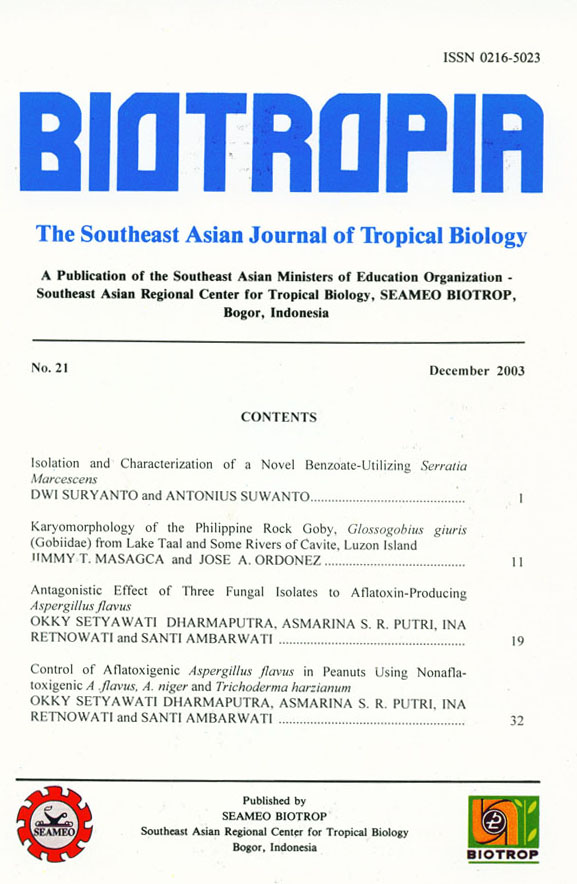
Tags
CONTROL OF AFLATOXIGENIC Aspergillus flavus IN PEANUTS USING NONAFLATOXIGENIC A. flavus, A. niger and Trichoderma harzianum
Content Language : English

The effects of nontoxigenic Aspergillus flavus, A. niger and Trichoderma harzianum inoculated into planting
media on toxigenic A. flavus infection and its aflatoxin production in peanut kernels at harvest were investigated
together with (1) the moisture content of planting media before peanut planting, at the time of inflorescence, and at
harvest, (2) the population of aflatoxigenic and nonaflatoxigenic A. flavus, A. niger and T. harzianum in peanut
planting media before peanut planting, at the time of inflorescence, and at harvest, (3) the moisture content of
peanut kernels at harvest, and (4) toxigenic A. flavus invasion in peanut plant parts (roots, stems, petioles, leaves
and flowers) at the time of inflorescence.
The fungal isolates were inoculated into planting media at the same time with the planting of peanut
seeds. Peanut plants were grown under glasshouse conditions. Treated planting media were inoculated with the
combined use of (1) toxigenic and nontoxigenic A. flavus, (2) toxigenic A. flavus and A. niger, and (3) toxigenic A.
flavus and T. harzianum. Planting media inoculated only with each fungal isolate and uninoculated planting media
were used as controls. Two watering treatments of peanut plants were carried out, i.e. watering until harvest and not
watering for 15 days before harvest. The populations of the fungal isolates in the planting media and peanut kernels
were determined using dilution method followed by pour plate method; the percentages of toxigenic A. flavus and
test fungal colonizations in peanut plant parts were determined using plating method; the moisture content of
planting media and peanut kernels were determined using oven method; the aflatoxin content of peanut
kernels was determined using Thin Layer Chromatography method.
The results indicated that at the time of harvest the decrease in moisture contents of planting media not watered
for 15 days before harvest was higher than those watered until harvest. The lowest population of toxigenic A. flavus
was in planting media inoculated with the combined use of toxigenic and nontoxigenic A. flavus at the time of
inflorescence and at the time of harvest. Toxigenic A. flavus could invade the roots, stems and flowers of peanut
plants. The lowest percentage of invasion was on the plant parts which planting media were inoculated with the
combined use of toxigenic and nontoxigenic A. flavus. The moisture content of peanut kernels originated from
watered plants until harvest were higher than those not watered for 15 days before harvest. The population of
toxigenic A. flavus in peanut kernels derived from the plants whose planting media were inoculated with the
combined use of toxigenic A. flavus and each test fungi, was lower than those inoculated only with toxigenic A.
flavus. It indicated that the test fungi inoculated into planting media could inhibit toxigenic A. flavus infection in
peanut kernels. Aflatoxin was only detected in peanut kernels originated from one plant whose planting medium
was inoculated only with toxigenic A. flavus and the plant was watered until the time of harvest. Toxigenic A. flavus
infection and aflatoxin production were not influenced by planting media which were not watered for 15 days before
harvest.
Link

This work is licensed under a Creative Commons Attribution-NonCommercial-NoDerivatives 4.0 International License.
